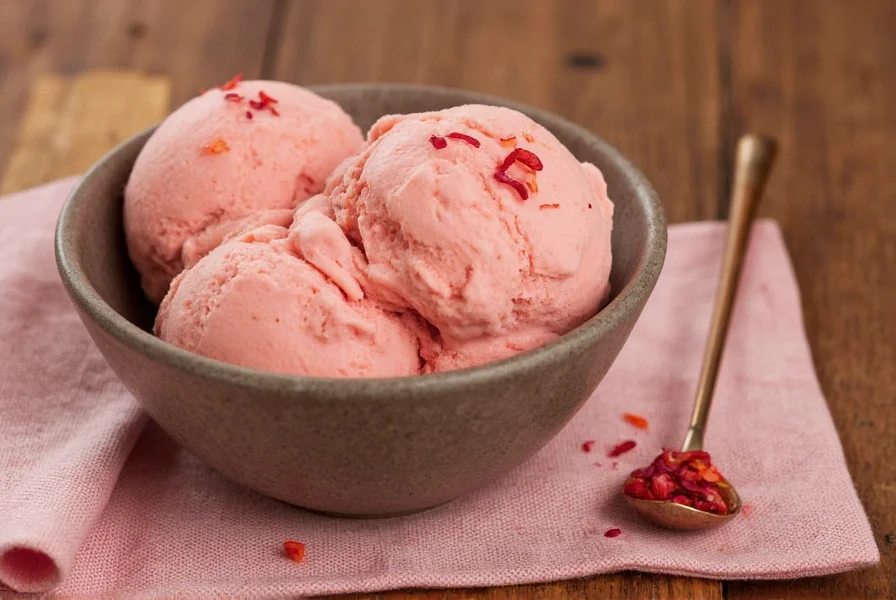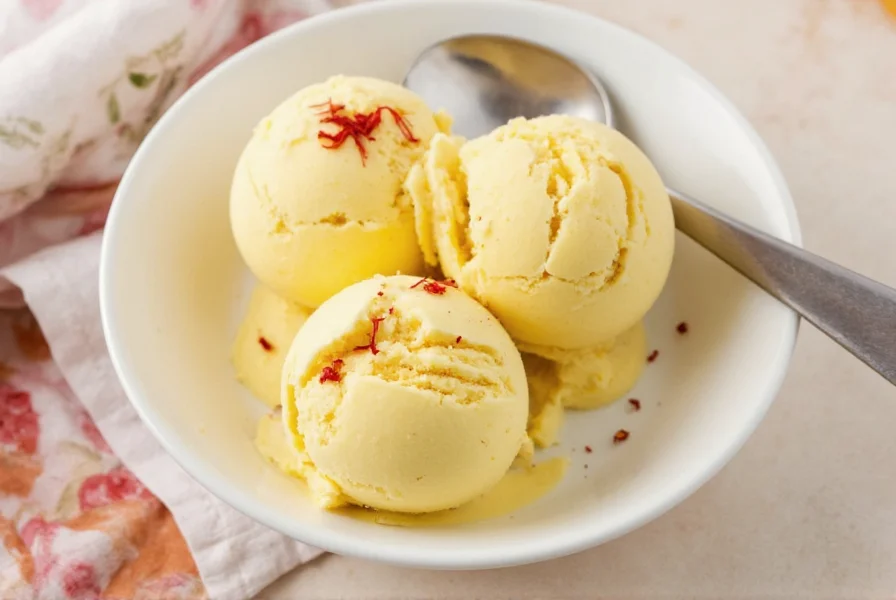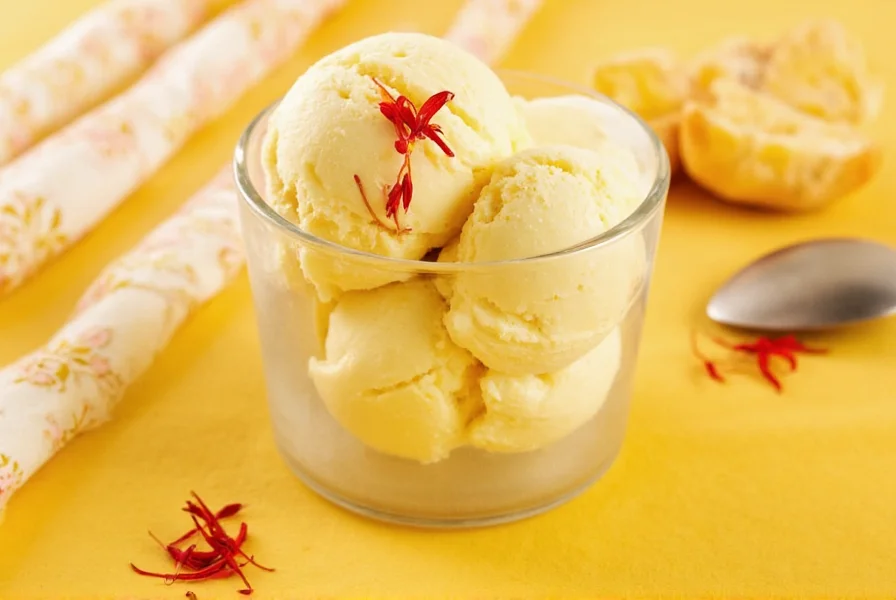Saffron ice cream represents one of the world's most ancient and sophisticated frozen desserts, with roots tracing back centuries to Persian culinary traditions. Unlike common vanilla or chocolate varieties, this specialty ice cream transforms the world's most expensive spice into a creamy, aromatic delight that engages multiple senses simultaneously. The vibrant golden hue, delicate floral notes, and subtle earthy undertones create an experience that transcends ordinary frozen treats.
The Historical Journey of Saffron Ice Cream
Saffron ice cream's origins lie in ancient Persia (modern-day Iran), where ice houses called "yakhchāl" stored winter ice for summer use. Persian chefs combined this precious ice with saffron-infused milk to create "sharbat-e bastani", an early form of what we now recognize as saffron ice cream. This culinary innovation spread along trade routes to India, where Mughal emperors embraced it as "kulfi", and eventually influenced Mediterranean and European frozen dessert traditions.
Unlike modern ice cream made with churned cream, traditional saffron ice cream often uses reduced milk (malai) for richness, creating a denser texture similar to kulfi. The spice's journey from crocus flower stigmas to frozen dessert showcases remarkable culinary adaptation across civilizations.
What Makes Saffron Ice Cream Unique
The distinctive qualities of saffron ice cream stem from the complex chemistry of genuine saffron. Each gram contains over 150 aromatic compounds, with safranal providing the characteristic floral scent and crocin delivering the intense golden color that intensifies when heated. Unlike artificial colorings, saffron's hue remains stable through the freezing process, creating that signature sunset appearance.
| Characteristic | Saffron Ice Cream | Traditional Vanilla |
|---|---|---|
| Color | Golden yellow to orange | Creamy white |
| Flavor Profile | Floral, earthy, honey-like | Sweet, creamy, bean notes |
| Texture | Denser, less airy | Lighter, more aerated |
| Preparation Time | Longer (saffron infusion) | Shorter |
Authentic saffron ice cream never tastes medicinal despite saffron's potent nature. Proper preparation requires patience—steeping threads in warm milk for 20-30 minutes allows gradual flavor release without bitterness. The resulting flavor balances floral elegance with subtle earthiness, creating complexity that evolves on the palate.
The Science Behind Perfect Saffron Infusion
Creating exceptional saffron ice cream depends on understanding the spice's solubility properties. Crocin (the coloring compound) dissolves best in warm liquids, while safranal (the aroma compound) requires careful temperature control. Professional chefs use a two-stage infusion:
- Cold infusion: Steeping threads in cold milk overnight extracts delicate floral notes
- Warm infusion: Gently heating the mixture releases deeper color and earthy undertones
This dual approach maximizes flavor complexity while preventing the bitter compounds that emerge at high temperatures. The ideal saffron-to-milk ratio ranges from 0.1-0.3 grams per liter—enough for distinctive flavor without overwhelming the palate.

Traditional Preparation Methods vs. Modern Adaptations
Traditional Persian saffron ice cream (bastani sonnati) combines saffron with rose water and pistachios, creating a harmonious flavor trio. The authentic method involves slowly reducing whole milk to concentrate flavors before adding sugar and saffron. This reduction process develops caramelized milk notes that complement saffron's complexity.
Modern interpretations have expanded this foundation while respecting core principles. Some notable variations include:
- Indian kulfi style: Uses khoya (reduced milk solids) for intense richness
- Mediterranean version: Incorporates orange blossom water alongside saffron
- Contemporary fusion: Combines with cardamom or saffron-infused honey
Regardless of variation, authentic saffron ice cream maintains three essential elements: genuine saffron threads (not powder), slow infusion process, and balanced flavor profile where saffron enhances rather than dominates.
Creating Authentic Saffron Ice Cream at Home
Home preparation requires attention to detail but yields exceptional results. Follow these steps for authentic saffron ice cream:
- Crush 0.2g saffron threads and steep in 2 tablespoons warm whole milk for 30 minutes
- Heat 2 cups whole milk with 1/2 cup sugar until steaming (do not boil)
- Whisk in saffron mixture and 1/4 teaspoon rose water
- Cool completely, then churn in ice cream maker according to manufacturer instructions
- Before final freeze, fold in 1/4 cup finely chopped pistachios
Critical success factors include using fresh saffron (stale threads lose potency), avoiding high heat that creates bitterness, and allowing proper aging time (24 hours) for flavors to meld. The golden color should deepen as it freezes—pale results indicate insufficient saffron or improper infusion.

Serving Traditions and Pairing Suggestions
Saffron ice cream's versatility shines in traditional and contemporary presentations. In Iran, it's commonly served between layers of traditional rice pudding (sholeh zard) or alongside Persian cookies. The classic bastani sonnati presentation includes a wedge of ice cream topped with pistachios and rose petals.
Modern pairings that enhance saffron's complexity include:
- Fresh stone fruits like apricots or peaches
- Dark chocolate shavings (70% cacao or higher)
- Honeycomb or Persian saffron honey
- Cardamom-infused shortbread
Temperature matters significantly—serve saffron ice cream slightly warmer than standard ice cream (around 12°F/-11°C) to allow full flavor expression. The delicate floral notes become muted at extremely cold temperatures.
Frequently Asked Questions
What gives saffron ice cream its distinctive color?
Saffron ice cream gets its vibrant golden color from crocin, a natural carotenoid pigment in saffron threads. Unlike artificial colorings, crocin produces a luminous golden hue that intensifies when heated during preparation and remains stable through the freezing process. Genuine saffron creates a color that ranges from pale yellow to deep orange depending on concentration.
Why is saffron ice cream more expensive than regular ice cream?
Saffron ice cream costs more due to saffron being the world's most expensive spice by weight. It takes approximately 150,000 crocus flowers to produce one kilogram of saffron threads, requiring painstaking hand-harvesting of delicate stigmas. Authentic saffron ice cream uses genuine threads (not powder or substitutes), with even small amounts significantly increasing production costs while delivering distinctive flavor and color.
Can I make saffron ice cream without an ice cream maker?
Yes, you can make saffron ice cream without an ice cream maker using the 'still-freeze' method. After preparing the saffron-infused custard base and chilling it thoroughly, pour into a shallow metal container and freeze. Every 30 minutes for 3-4 hours, remove and vigorously stir with a fork to break up ice crystals. This manual churning creates smaller ice crystals for smoother texture, though results won't be quite as creamy as machine-churned versions.
How can I tell if saffron ice cream contains real saffron?
Authentic saffron ice cream shows several indicators: visible red-orange threads in the mixture, a deepening golden color as it freezes, a complex floral-earthy aroma rather than单一 medicinal scent, and flavor that evolves on the palate. Fake versions often use artificial coloring (producing uniform yellow without depth) and may have bitter or one-dimensional taste. Real saffron ice cream maintains its color intensity when melted, while artificial versions often fade.











 浙公网安备
33010002000092号
浙公网安备
33010002000092号 浙B2-20120091-4
浙B2-20120091-4